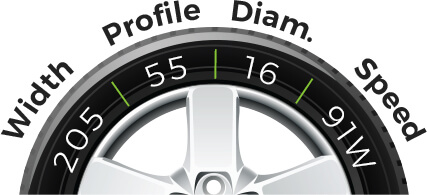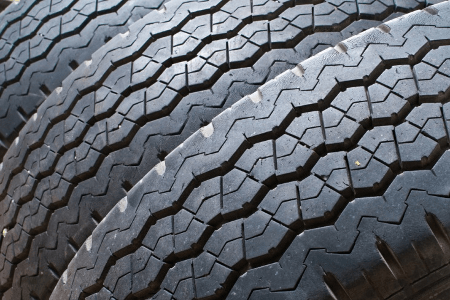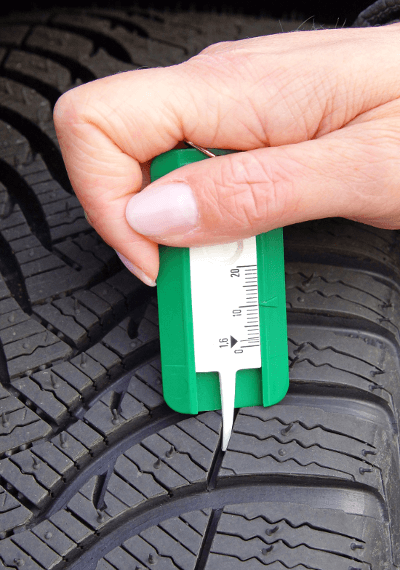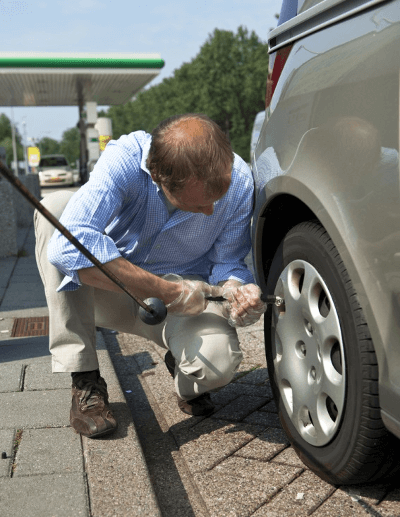Huge offers on this April. Save up to £20 on Selected brands or get £70 Back. View All offers
Fitted Locally
-at a garage near you
All Inclusive Price
-what you see is what you pay
Big Brands
-at Asda prices
Huge offers on this April. Save up to £20 on Selected brands or get £70 Back. View All offers
at a garage near you
what you see is what you pay
at Asda prices
If you’ve never ordered tyres online before you can watch the video below to see how easy it is.
Or if you’re having trouble understanding a particular section of the website you can choose a chapter via the playbar on the video.
Under new European regulations, as of 1 November 2012, all tyres must be sold with an accompanying label which clearly states their performance on wet roads, fuel economy, rolling distance and road noise.
This new law, which affects all passenger and light truck tyres, gives consumers information unlike ever before.
The new tyre labels are extremely easy to read and they are instantly recognisable as they have the same rating system as white goods i.e. washing machines and fridges, by colour coding letters for performance.
Tyres will be rated on a scale of A-G (A being the best) - so it is instantly understandable which tyres have the best performance and which don't perform as well as others. This is very good for the consumer as they can always see which tyre will give them the best value for money simply by looking at tyre labels instead of having to look through reviews.
Using this part of the tyre label you can immediately see how the tyre will affect your car's fuel efficiency.
Tyres that are rated "A" will give you a much more efficient drive than those rated "G".
It is a wise choice to choose a tyre that is more fuel efficient. It is not only a massive benefit to you, by saving you money and taking more time between trips to the pump, but it also has a more positive environmental effect than lower rated tyres.
A car fitted with four A-rated tyres will save a massive 80 litres of fuel over the life of the tyres, which is the equivalent of over a whole tank of petrol saved and roughly £110 with today's prices. Driving at 50mph, A-rated tyres will use around 7.5% less fuel than if your tyres were G-rated.
How your tyres perform on wet roads is extremely important. They are the only thing keeping you on the road, and with the risk of aquaplaning during very bad weather, choosing a tyre that has a higher wet performance rating than others could potentially be life-saving.
Again, you can review how well a tyre has been classified with the A-G rating, with A-rated tyres having a much shorter stopping distance, and therefore being much safer than G-rated tyres.
If you have a car with four A-rated tyres, you will stop up to four car lengths quicker than G-rated tyres, which can prevent crashes and potentially save lives. At 50mph you will have a decreased stopping distance of up to 18m, which is up to 30% better than more poorly rated tyres.
This diagram is different to the A-G rated symbols of the fuel efficiency and wet grip. Tyres are rated on a scale of three noise waves, as well as a decibel level of what the maximum noise level recorded for that tyre is. In the future, regulations will be put in place to set a maximum road noise level from tyres.
If a tyre has three black waves then it is one of the noisier tyres. It means that the level of noise that it emits is actually greater than what the future regulation will be, but it is still legal by today's standards.
Two waves mean that a tyre performs at an average level and the noise emitted is equal to, or three decibels lower than, the future regulations.
A single wave indicates a very low noise from the tyre. You will get a minimum of three decibels lower than the future noise limit - and even lower in some cases. Three decibels might not sound like a lot of difference, but you will certainly realise the change when you start driving.
Don't forget, the noise that you hear inside the car isn't always relative to the noise being emitted by your tyres on the outside.
Tyre size can be found on the sidewall of a tyre and appears as a combination of numbers and letters. Knowing what each section of these numbers and letters mean will make it very easy to find your car's tyre size. The below image shows a tyre with a mixture of numbers and letters: 205 55 R16 91W.

To explain the tyre size further we have broken each section down, explaining what each number and letter means.
Sidewall Marking |
Explanation |
|---|---|
205 |
The width of the tyre in millimetres |
55 |
Height of the tyre sidewall as a percentage of the width |
R |
The tyre is of radial construction |
16 |
The tyre's inner rim diameter in inches |
91 |
The load rating of the tyre |
W |
This speed rating - the tyres maximum speed at full load |
The tyre load rating indicates the maximum weight each tyre is able to carry.
If a tyre with an incorrect load capacity is fitted to your car your insurance policy can become void in certain cases. It is therefore vital to check your car is fitted with a tyre with the correct load rating.
The table below shows the weight capacity in kilograms of each load rating.
Load index |
Load in kg |
Load index |
Load in kg |
Load index |
Load in kg |
|---|---|---|---|---|---|
62 |
265 |
84 |
500 |
106 |
950 |
63 |
272 |
85 |
515 |
107 |
975 |
64 |
280 |
86 |
530 |
108 |
1000 |
65 |
290 |
87 |
545 |
109 |
1030 |
66 |
300 |
88 |
560 |
110 |
1060 |
67 |
307 |
89 |
580 |
111 |
1090 |
68 |
315 |
90 |
600 |
112 |
1120 |
69 |
325 |
91 |
615 |
113 |
1150 |
70 |
335 |
92 |
630 |
114 |
1180 |
71 |
345 |
93 |
650 |
115 |
1215 |
72 |
355 |
94 |
670 |
116 |
1250 |
73 |
365 |
95 |
690 |
117 |
1285 |
74 |
375 |
96 |
710 |
118 |
1320 |
75 |
387 |
97 |
730 |
119 |
1360 |
76 |
400 |
98 |
750 |
120 |
1400 |
77 |
412 |
99 |
775 |
121 |
1450 |
78 |
425 |
100 |
800 |
122 |
1500 |
79 |
437 |
101 |
825 |
123 |
1550 |
80 |
450 |
102 |
850 |
124 |
1600 |
81 |
462 |
103 |
875 |
125 |
1650 |
82 |
475 |
104 |
900 |
126 |
1700 |
83 |
487 |
105 |
925 |
The speed rating of a tyre is indicated by a letter at the end of the tyre size on the sidewall of the tyre, and specifies the maximum speed your tyre is capable of maintaining.
For example a tyre with a speed rating of "W" can reach speeds of up to 168mph.
A tyre's speed rating is the result of specific tests ran by engineers. These involve running the tyre at 6.2mph steps in ten minute increments until the required speed has been met.
If your car is fitted with a tyre with a lower speed rating than is appropriate for your vehicle you could invalidate your insurance policy, therefore it is essential you check your car's speed rating before purchasing new tyres.
The table below shows the maximum speed in mph of each speed rating.
Sidewall Marking |
Explanation |
|---|---|
N |
87 |
P |
93 |
Q |
99 |
R |
106 |
S |
112 |
T |
118 |
U |
124 |
H |
130 |
V |
149 |
Z |
150+ |
W |
168 |
Y |
186 |
Worn, incorrectly inflated or damaged tyres are illegal. Driving with illegal tyres puts you at risk of being fined and invalidating your insurance policy. Tyres are responsible for braking distance and traction on the road, therefore safety can also be compromised.

The law requires all vehicles using UK roads; be fitted with the correct size and type of tyre for the vehicle, have all tyres inflated to their recommended tyre pressure and ensure a minimum tread depth of 1.6mm.
If you are pulled over by a police officer and your vehicle is fitted with an illegal or defective tyre you may be issued a Fixed Penalty Notice, or in Scotland, a Conditional Offer Notice. The police officer can, at their discretion, not issue a fixed penalty but instead report the case for prosecution. In this case the driver and owner (if different) will be liable. The maximum fine a court can impose is £2,500 per tyre and 3 penalty points. Disqualification is also possible in certain circumstances.
Tyre integrity also impacts handling, stability, comfort and fuel economy. Damaged or low pressure tyres will use more fuel, costing you more money and increasing CO2 emissions.
Tyre tread is designed to create grip and displace water. It comprises of the pattern of grooves along the surface of the tyre.
You can use a tyre tread gauge or 20p piece to check your tyre tread is within the legal limit of 1.6mm.

Ensure your car is parked in a safe place where you are able to check each tyre. If using a gauge place it between the grooves, taking the reading from the central third of the tread, if it reads over 1.6mm the car is safe to drive.
If using a 20p piece perform the same procedure, but use the outer banner of the coin as a guide. If this is not visible the tyre is legal to drive on. If the coin doesn't go deep enough into the tread the tyre will be illegal.
Although the legal limit is 1.6mm, tyre efficiency is highly reduced when the tread is below 3mm, especially in wet conditions when stopping distance is increased. It is therefore advised that tyres are replaced before they reach the legal limit.
Not only is tyre pressure important because it is a legal requirement, it also improves handling and fuel consumption of the vehicle.
Each vehicle has a specified tyre pressure which can be found on a sticker inside the door frame of the car.
Most petrol stations have a digital air pressure machine, some of which are available to use free of charge. You can also check your tyre pressure from home using a metal air pressure gauge.

To measure pressure simply remove the cap and place the gauge over the top and the reading will be displayed.
Depending on the reading you can then either add more air or release some to change the tyre pressure. Be aware that front and back tyres require different amounts of air pressure; this will be made clear on the sticker inside the door and in your vehicle handbook.
It is important to regularly check your tyres for any slits, tears, bulges or areas which are particularly worn as this could be an indication that there is an issue with the vehicle, for example the wheels need re-aligning.
You should check your tyres' condition, tread and pressure regularly, so you can spot any potential problems early. If you do find you need new tyres Asda Tyres has a great selection from all the leading brands at low prices!
Asda Tyres has invested heavily in improving and expanding our all inclusive tyre service. We have worked hard to ensure our fully fitted option is as straight forward & convenient as it can be.
Either, enter your vehicle registration number or your tyre size into one of our search tools and select the tyres you want from the list. All the tyres shown after you’ve entered your registration number or the size will be suitable for your vehicle.
Once you’ve selected your tyres, you will need to enter your postcode and you will see the nearest fitting centre to your postcode. We work alongside hundreds of tyre fitting centres throughout the UK and the vast majority of the UK population will have a centre within a few miles of their specified postcode.
Each fitting centre has been vetted and is fully insured to carry out work on our behalf. Once you have selected a local fitting centre, you can choose a date and time most convenient for you.
Once you have placed your order all you need to do is turn up at your appointment and our team will fit your new tyres and dispose of your old ones.
Asda Tyres is operated by Colewood Automotive Ltd under contract with Asda. Registered in England No. 10828348, VAT No. 273208316. Registered Office 1 Kingfisher Court, Bowesfield, Stockton on Tees, North Yorkshire, TS18 3EX